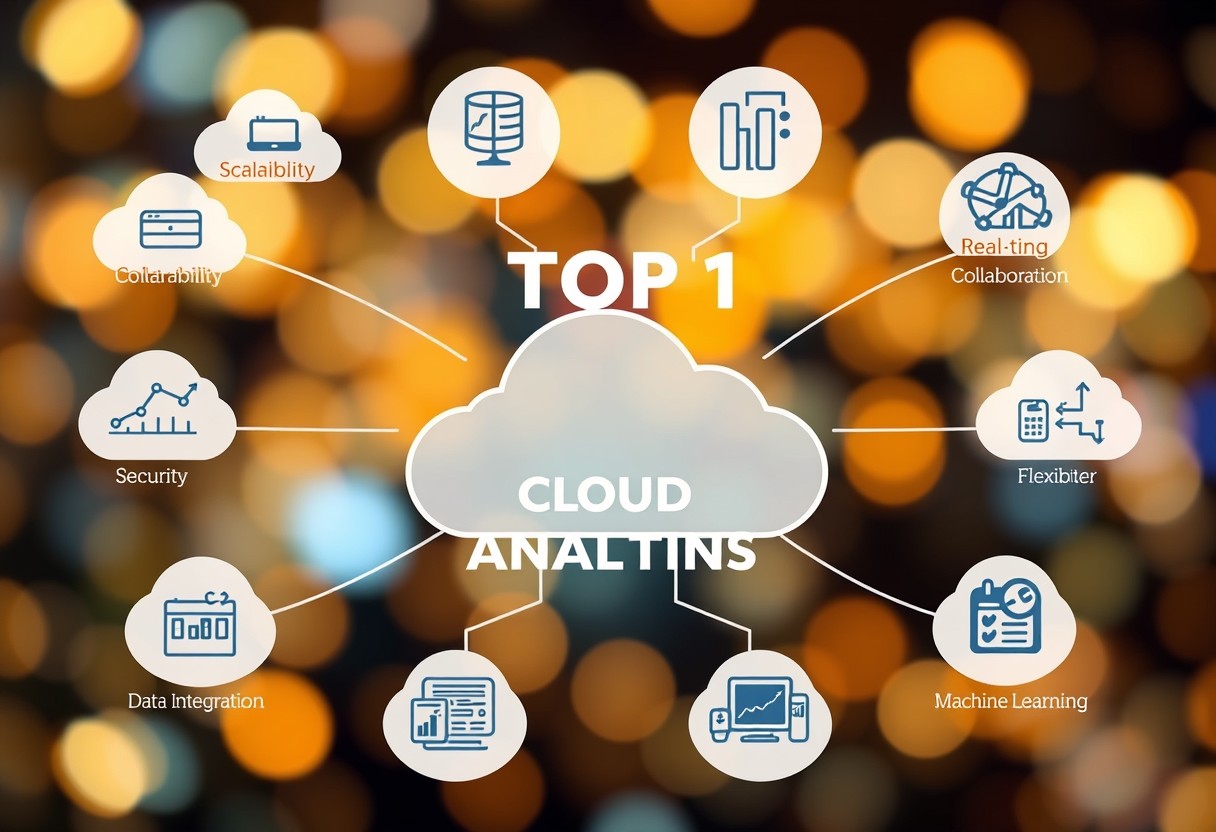
Over my years of experience in the technology field, I’ve discovered a multitude of benefits that come with leveraging cloud computing for big data analytics. In this post, I’ll highlight the top 10 advantages, which can transform how you manage, analyze, and extract valuable insights from massive data sets. You can expect enhanced scalability, improved cost efficiency, and the flexibility to access your data from anywhere, ensuring that your business stays ahead in today’s competitive landscape.
Scalability
To effectively manage large volumes of data, scalability is one of the most significant advantages of using cloud computing for big data analytics. With the ability to dynamically adjust resources as necessary, you can ensure that your data processing capabilities align with your current needs. This flexibility helps organizations manage costs, as they only pay for the resources they use without being locked into expensive long-term contracts or investments in physical infrastructure.
On-demand resource allocation
Any organization that deals with fluctuating workloads understands the value of on-demand resource allocation. Cloud computing allows you to provision resources instantly without the lengthy processes associated with traditional hardware installations. This means that when there are sudden spikes in data volume or analytics demand, you can quickly scale up your infrastructure to handle the load without experiencing downtime or reduced performance.
Adjust capacity easily
You have the opportunity to adjust your cloud resources easily based on actual data processing requirements. Whether your analytics needs increase or decrease, cloud services offer the flexibility to scale resources up or down in a matter of minutes. This adaptability enables you to manage operational costs efficiently, as you won’t be spending on excess capacity that you don’t need. (Assessing your organization’s data growth pattern is vital in making informed decisions about capacity adjustments.)
Easily resizing instances and adding storage or computational power allows you to respond swiftly to changing business demands. This capability positions your organization to capitalize on opportunities and manage risks effectively, ensuring that you remain competitive in today’s fast-paced data-driven landscape. (Strategic planning and clear forecasts can significantly guide your decisions on resource adjustments.)
Cost-effectiveness
It is no secret that cost-effectiveness is one of the most compelling reasons to adopt cloud computing for big data analytics. By utilizing cloud services, I have found that organizations can significantly reduce their overall expenses when compared to traditional on-premises solutions. The financial burden of maintaining physical infrastructure, including servers and storage devices, can be overwhelming—especially for businesses that rely heavily on data analysis. With cloud computing, companies can shift much of that responsibility to their service providers, allowing them to focus their resources on core business operations.
Lower infrastructure costs
While evaluating the cost benefits of cloud computing, I quickly realized that lower infrastructure costs were a game-changer for many businesses. Instead of investing heavily in hardware that may quickly become outdated, companies can leverage scalable cloud resources that adapt to their needs. This flexibility means that you only pay for what you use, which can lead to substantial savings over time. With cloud computing, there’s no longer a need to purchase and maintain extensive hardware fleets, making it an attractive option for businesses of all sizes.
Pay-as-you-go model
An additional financial benefit of cloud computing lies in the pay-as-you-go model. This innovative approach allows businesses to pay only for the storage and processing power they actually utilize. As a result, companies can avoid the hefty upfront costs associated with traditional infrastructure investments. Instead of committing to substantial financial outlays, you can scale your data resources as needed, which not only helps manage cash flow more effectively but also minimizes waste in resource allocation.
To further enhance your understanding, this model ensures that you can align your spending with your actual usage patterns. For instance, during peak periods of data analysis, you may require more resources, and you can simply scale up, paying only for that extra capacity. Conversely, during off-peak times, you can scale down to save costs. This level of flexibility not only improves budget management but also allows for greater experimentation and agility in your big data initiatives.
Flexibility
With the rise of cloud computing, you gain the advantage of unmatched flexibility in your data management and analytics efforts. You can easily scale resources up or down based on your specific analytics requirements, which means you can accommodate varying volumes of data without overcommitting resources. This level of elasticity allows you to optimize your costs and improve operational efficiency, particularly when dealing with large datasets in a rapidly changing environment.
Support Various Data Types
You have the ability to handle multiple types of data—structured, semi-structured, and unstructured—effectively. Whether it’s relational databases, NoSQL databases, or data lakes, cloud platforms are designed to process diverse formats. This variety enables you to aggregate insights from various sources, enhancing your analytics capabilities.
| Data Type | Examples |
| Structured | SQL databases, Data Warehouses |
| Semi-Structured | XML, JSON |
| Unstructured | Text, Images, Videos |
| Time-Series | Log Data, IoT Data |
| Spatial Data | Geographical information, GPS Data |
After leveraging such diverse data types, you can unlock deeper insights and trends that can significantly enhance your decision-making process. Cloud computing’s flexibility is a game changer, providing you with an edge in the competitively evolving landscape of big data analytics.
Integration with Existing Tools
For a seamless analytics operation, cloud computing allows for easy integration with your existing tools and applications. This ensures that your current workflows are not disrupted but rather enhanced with additional cloud-based functionalities. Being able to effectively link your on-premise systems to cloud solutions is vital for maintaining data continuity and leveraging all available analytical resources. (This aspect emphasizes that existing infrastructure can be significantly enhanced through cloud technologies).
This integration capability allows you to utilize popular analytics tools like Tableau, Power BI, or even proprietary solutions without extensive modifications. I find that such compatibility not only accelerates deployment but also improves the return on investment for your technology stack. (Adopting cloud solutions should align with your current technological landscape for maximum effectiveness).
With cloud computing, you can enjoy a level of flexibility that allows you to navigate the complexities of big data analytics with ease, ensuring that your analytical capabilities can grow and adapt alongside the evolving needs of your organization.
Improved Collaboration
Keep in mind that cloud computing enables seamless collaboration among teams, especially when it comes to managing and analyzing big data. The ability to work together in real-time can significantly enhance productivity and innovation. With data stored in the cloud, team members can access the same datasets simultaneously from different locations, which fosters a more integrated approach to problem-solving and decision-making. I find that this collaborative environment often leads to richer insights and a more thorough analysis of data trends.
Real-time Data Sharing
Assuming your organization adopts cloud technology for big data analytics, you will benefit from the capability for real-time data sharing. This means that as data gets updated or analyzed, every team member can view and respond to changes instantly. No longer do we need to wait for reports or emails to share insights; everything is available at our fingertips. This immediacy enhances decision-making, as your team can adapt strategies based on the latest information.
Access from Anywhere
The flexibility of cloud computing means that you can access your big data analytics tools and insights from anywhere, as long as you have an internet connection. This is particularly beneficial if you’re traveling or if your team is distributed across multiple locations. You will find that being able to access data on-the-go contributes to a more dynamic workflow and enables you to engage with your projects more actively, even when you’re not physically present in the office. (Making a decision to adopt cloud technology could redefine how you manage your work-life balance.)
With cloud computing, your ability to conduct business and access critical analytics information anytime, anywhere enhances not only your productivity but also the overall agility of your organization. This flexibility allows you to respond promptly to market changes and share insights with stakeholders, facilitating a more responsive approach to business strategy. (Investing in cloud infrastructure could be one of the smartest choices you make for your future success.)
Data Security
After exploring the various advantages of cloud computing, one of the most significant aspects that I believe deserves emphasis is data security. In today’s digital landscape, where big data analytics is a cornerstone of informed decision-making, ensuring that your data remains secure is paramount. The traditional methods of storing and processing data often expose businesses to a range of vulnerabilities. With cloud computing, you gain access to advanced security measures that safeguard your valuable information.
Advanced Encryption Methods
Advanced encryption methods are one of the pivotal features that enhance data security in cloud environments. Most cloud providers implement strong encryption protocols to protect your data both in transit and at rest. Using industry-standard encryption algorithms, they ensure that unauthorized individuals cannot access sensitive information. This level of protection significantly reduces the risk of data breaches.
Additionally, cloud security providers often offer customizable encryption solutions, allowing you to tailor the security settings based on your organization’s unique needs and compliance requirements. (This flexibility is vital in adapting to various regulations and business environments.)
- Data is encrypted during transfer and storage, lessening the chance of interception.
- Top-tier cloud providers apply regular updates to their security protocols.
- Only authorized users have access to sensitive data through role-based permissions.
- Secure keys management practices further enhance data protection.
Regular Security Updates
An imperative part of maintaining data security in cloud computing is the regular security updates provided by cloud service providers. With the ever-evolving landscape of cybersecurity threats, it is imperative that you stay ahead by implementing these updates. By using cloud services, you ensure that your systems are continuously fortified against the latest vulnerabilities and exploits. (Staying updated is non-negotiable for protecting your data.)
With cloud providers dedicated to maintaining their systems, they regularly deploy security patches and upgrades that mitigate risks associated with new vulnerabilities. This ongoing commitment to security means that I can focus on leveraging big data analytics without the constant worry of data breaches or security incidents. (Adopting this approach can significantly minimize the risk of a data compromise.)
It is beneficial to note that opting for a cloud solution with a proven track record in providing regular security updates allows you to deal with threats proactively. This not only enhances your data security posture but also builds trust with your stakeholders, knowing that your organization prioritizes protected information. In this age of rapid technological advancement, not leveraging such updates would leave your data susceptible to substantial risks.
Performance Optimization
Once again, utilizing cloud computing for big data analytics presents significant opportunities for performance optimization. This optimization fosters a more efficient and streamlined approach to processing large datasets, ultimately leading to better decision-making and insights. In a world where data is generated at an unprecedented rate, harnessing the power of the cloud allows for scalable resources that can be adjusted in real-time to meet fluctuating analytical demands.
High-speed Processing
Optimization starts with high-speed processing, which is one of the greatest advantages of cloud computing. By leveraging cloud infrastructure, I can access powerful computing resources that allow for the rapid execution of complex algorithms and data analysis. This capability is instrumental when you need to analyze vast amounts of data with minimal delay, ensuring that your insights are timely and relevant. The cloud eliminates many of the bottlenecks commonly associated with traditional on-premises systems, leading to faster outcomes.
Efficient Data Storage
Now, let’s turn our focus to efficient data storage, another vital aspect of performance optimization in cloud computing. By employing cloud solutions, you can store massive volumes of data without the limitations imposed by physical hardware. This flexibility not only helps in maintaining an organized data set but also ensures that costs are minimized since you pay only for the storage space you actually use. (Choosing the right storage solution is imperative to maximizing performance.)
Efficient data storage allows for advanced analytics capabilities that can quickly scale based on your organization’s needs. With a cloud-based architecture, your data can be distributed across multiple locations and readily accessible, facilitating faster retrieval and analysis. Additionally, cloud providers often implement sophisticated redundancy measures that safeguard your data, ensuring its integrity and availability when you need it most. (The choice of cloud storage affects both performance and data accessibility.)
Automated Backups
All businesses that depend on data must consider the significance of reliable backups. Automated backups ensure that your data is securely saved without requiring constant manual intervention. This is particularly advantageous for those working with big data analytics, as the volume of data can be overwhelming. With cloud computing, I have found that scheduled backups streamline the process, providing peace of mind and saving time, so you can concentrate on analyzing your data rather than managing it. (The decision on how frequently to back up your data can significantly impact your operations.)
Scheduled Data Preservation
Some cloud computing solutions offer scheduled data preservation settings that allow you to tailor backup frequencies according to your business needs. By establishing a schedule, you can rest assured that your data will be captured consistently, whether it’s hourly, daily, or weekly. This becomes especially important in fast-paced environments where data changes rapidly, and missing a backup could lead to the loss of valuable insights or operational continuity.
Disaster Recovery Solutions
Data corruption or loss can occur unexpectedly, making reliable recovery plans indispensable. Disaster recovery solutions in cloud computing offer robust support for regaining access to your data when the unthinkable happens. I appreciate how these solutions automatically replicate data across multiple locations, ensuring that a backup is always accessible, even in the face of system failures or catastrophic events.
The technology behind these disaster recovery solutions often includes real-time replication and the use of multiple redundancy strategies. By hosting your big data analytics in the cloud, I’ve found that you maintain an enhanced level of security and reliability. If you ever face a data loss event, you can quickly restore operations using the most recent backups, minimizing operational downtime and safeguarding your business against revenue loss. Understanding and implementing these disaster recovery solutions can be the difference between quickly recuperating or facing extended disruptions.
Advanced Analytics Tools
Your journey into the world of big data analytics is greatly enhanced by the use of advanced analytics tools provided by cloud computing. These tools offer robust features that enable organizations to derive valuable insights from their data, streamline processes, and enhance decision-making. Here are just some of the key benefits you can expect:
- Scalability
- Real-time data processing
- Cost efficiency
- Collaboration capabilities
- Improved data visualization
- Integration with existing systems
- Enhanced security measures
- Access to advanced algorithms
- Increased data storage
- Faster iterations of data analysis
| Feature | Benefit |
|---|---|
| Machine Learning Capabilities | Automates data analysis and enhances predictive accuracy. |
| Predictive Analysis Features | Forecasts trends and outcomes based on historical data. |
Machine Learning Capabilities
On utilizing the machine learning capabilities inherent in cloud computing, I find that organizations can automate complex analyses that would traditionally require significant human resources. With advanced algorithms available in the cloud, you can train models on vast amounts of data, which allows for higher accuracy and efficiency. These capabilities facilitate the creation of predictive models that can adapt over time as more data becomes available, enabling you to make informed decisions based on current trends and insights.
This amalgamation of data and technology means that your organization can keep pace with market changes and customer needs. Additionally, the self-learning aspect of machine learning models ensures that they improve continuously, enhancing your ability to respond proactively to challenges and opportunities. In this context, it’s imperative to recognize how cloud computing empowers you to leverage these sophisticated technologies to gain competitive advantages in the fast-paced world of big data analytics. (Strategic adoption of these technologies could redefine your analytical potential.)
Predictive Analysis Features
There’s an undeniable value that predictive analysis brings to the table in your data analytics strategy. By leveraging historical data, I can forecast future trends and behaviors, which helps in making proactive decisions. This tool’s capabilities allow for detailed simulations and scenario analyses, providing a clearer view of potential outcomes and their associated risks.
Predictive analytics involves processes that scrutinize historical and current data to identify patterns, which can then be used to predict future events. With this feature, your organization can optimize its resources, minimize risks, and capitalize on opportunities. Embracing predictive analytics is not simply a matter of preference but it lays the foundation for creating a data-driven culture that prioritizes informed decision-making.
Reduced Maintenance
For many organizations, the shift to cloud computing offers a significant reduction in maintenance burdens. By utilizing cloud services for big data analytics, you can minimize the amount of IT management required. This allows your team to focus on more strategic projects rather than spending excessive time troubleshooting and maintaining servers and infrastructure. (Choosing the right cloud provider can have a lasting impact on your operational efficiency.)
Minimal IT Management Required
Some businesses may underestimate the amount of time and resources that supervising hardware can consume. With cloud computing, I’ve found that the maintenance related to software updates, backups, and general server management is handled by the cloud provider. This means fewer headaches for your IT staff and lower operational costs as they can now concentrate on developing innovative solutions instead of worrying about day-to-day server issues.
Less Hardware Upkeep
To further emphasize the benefits of cloud computing, you’ll find that reliance on physical servers is significantly diminished. This not only decreases the burden of hardware maintenance but also mitigates potential risks associated with frequent tech upgrades, physical damage, and obsolescence. As I’ve experienced firsthand, transitioning to the cloud means less time worrying about maintaining old devices and more time innovating your systems.
A move towards cloud computing frees you from the tedious tasks often associated with hardware upkeep. You don’t have to allocate resources for regular hardware upgrades or repairs, which can be both time-consuming and expensive. The cloud provides a scalable solution that evolves with your needs, allowing you to easily access cutting-edge technologies without the associated maintenance risks of traditional setups.
Conclusion
With this in mind, I believe that leveraging cloud computing for big data analytics presents a transformative opportunity for businesses looking to enhance their data strategy. The advantages of scalability, cost efficiency, flexibility, and accessibility cannot be understated. By embracing these technologies, you can manage vast amounts of data without the burden of excessive infrastructure costs. This allows you to focus more on deriving insights rather than spending valuable time and resources on maintaining hardware and software. Furthermore, having on-demand resources means you can adapt quickly to changing market conditions, ultimately improving your competitive edge.
In addition, using cloud platforms fosters collaboration and innovation within your team. By allowing for real-time data sharing and processing, I can empower you to make informed decisions faster. Security features provided by cloud services also ensure that your sensitive data is protected without requiring extensive internal resources. As I look towards the future, it is evident that integrating cloud computing into your big data analytics strategy is not just an option but a vital step toward achieving efficiency and wielding data as a strategic asset. Your journey into the cloud will pave the way for more informed decision-making and sustainable growth.





